Vintage neckties offer a unique way to add character and history to your look. Each decade from the 1920s through the 1990s had distinct tie styles – from the bold Art Deco patterns of the Jazz Age to the power ties of the ’80s. The key to incorporating these retro pieces today is balance: wear one vintage item at a time and pair it with modern clothing so you don’t appear to be in costume. Below, we break down the signature tie trends of each era and how to style them for formal events, business attire, and casual outfits in a modern wardrobe.
1920s: The Jazz Age & Art Deco Elegance
Tie Characteristics: The 1920s ushered in the modern necktie as we know it. Ties were loudly colorful, with vivid blues, maroons, golds, and silvers frequently seen. Bold patterns reigned – think thick diagonal stripes, club stripes (regimental stripes from British clubs), geometric Art Deco prints, polka dots, and paisley designs. Many men still wore bow ties (in plaids, dots, etc.), but long silk neckties grew in popularity. Neckties were relatively thin (about 2 to 2.5 inches wide) and often made of fine silk, as a man’s tie quality was a status marker. Knit ties also emerged – narrow wool knit ties with square ends were a trendy alternative for a casual look. Overall, 1920s ties exuded Art Deco elegance and Jazz Age flair.
How to Style a 1920s Tie Today:
- Formal: For a dressy event, channel Gatsby-era sophistication by pairing a 1920s-inspired tie with a three-piece suit. Opt for a silk tie in a classic Art Deco pattern or club stripe. For example, a navy-and-gold regimental stripe tie from the ’20s with a modern navy suit creates a polished look that nods to the Jazz Age. Add a tie bar or pin for vintage detail (as was common then). Keep the shirt white or light pastel so the tie’s bold pattern stands out. This subtle retro touch will look dapper without feeling like a costume.
- Business: Incorporate a 1920s tie into office wear by anchoring it with contemporary pieces. A striped or small paisley vintage tie can pop against a crisp modern dress shirt and tailored gray suit. Because original 1920s ties were shorter, use a tie clip to fasten the back blade instead of tucking it in your waistband. Choose a simple four-in-hand knot (the Windsor knot wasn’t yet common in the ’20s) and ensure the tie ends just above your belt line (typical for that era). This mix of a colorful vintage tie with a neutral suit lets your personality show in a professional setting while remaining balanced.
- Casual: 1920s ties were often very vibrant, which makes them great statement accessories for smart-casual outfits. Try wearing a vintage knit wool tie loosely with a button-down shirt and a lightweight v-neck sweater or cardigan. For example, a 1920s striped knit tie paired with a chambray shirt, rolled-up sleeves, and chinos creates a retro preppy vibe. You could also layer a tweed vest over the shirt for extra vintage flair. This way, the bold color or pattern of the tie becomes a fun focal point of an everyday look. In warm weather, you might even wear a vintage tie with a linen shirt (sleeves cuffed) and suspenders for a relaxed Peaky Blinders-style ensemble.
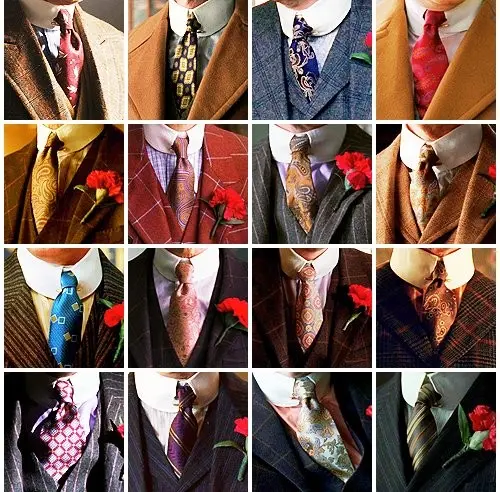
1930s: Sophistication and Swing
Tie Characteristics: The 1930s saw neckties become wider and even more eye-catching in pattern. Men’s neckwear shifted toward broader ties with vibrant colors and bold patterns. Early in the decade, earthy tones (moss greens, mustard yellows, peach, and soft blues) were common, but by the late ’30s, ties embraced brighter hues like deep blues, reds, and even black for contrast. Pattern-wise, everything clashed in the lively ’30s: horizontal stripes, tartan plaids, windowpane checks, polka dots (both large and pin dots), small paisleys, and Art Deco geometric designs all made appearances. This era also popularized hand-painted ties as wearable art – famous artists would paint abstract or modernist motifs on ties. Ties reached about 3.5 inches in width at their widest, complementing the wider suit lapels of the time. The Duke of Windsor influenced tie fashion as well – his namesake Windsor knot (a wide triangular knot) became fashionable for filling spread-collar shirts, which paired well with thicker ties. Overall, 1930s ties exuded a suave sophistication with a dash of exuberance from the Swing Era.
How to Style a 1930s Tie Today:
- Formal: Embrace the polished look of Old Hollywood by wearing a 1930s-style tie to a formal occasion. A rich-colored silk tie with an Art Deco geometric pattern or a tasteful plaid can be paired with a modern double-breasted suit (a nod to the ’30s when double-breasted suits were in vogue. For instance, a burgundy and navy plaid vintage tie will look sharp against a charcoal gray suit. Stick to a classic white dress shirt to let the tie’s pattern shine. You can even fold a pocket square in a coordinating color for extra elegance. This combination echoes the glamour of 1930s icons while still looking modern and refined.
- Business: Many 1930s ties were bold, but you can wear them in today’s workplace with the right styling. Choose one statement element and keep the rest muted. For example, take a wide 1930s tie with a vibrant Art Deco motif and pair it with a contemporary navy suit and light blue shirt. Make sure the suit has moderately broad lapels to accommodate the tie’s width (wider vintage ties look best with proportionally wider lapels. The suit’s solid color will ground the tie’s bold design. This strategy – letting the tie be the focal point against a simple backdrop – was true even historically (“bold 1930s ties work well with simple suits, allowing the tie to be the focal point”. Finish with brown leather oxfords for a timeless business look that subtly incorporates 1930s flair.
- Casual: For a retro-inspired casual outfit, use a fun 1930s tie as a conversation piece. Many ties from this era have whimsical patterns or color combos that can lighten up a casual look. Try wearing a vintage 30s tie with a cardigan or sweater vest instead of a suit jacket. For example, a 1930s tie with big polka dots or an abstract pattern could be worn over an Oxford cloth button-down, with a shawl-collar cardigan and dark denim. The layering tones down the tie’s formality. You might leave the top shirt button open and loosen the tie slightly for a relaxed feel. Another idea: incorporate a 30s-era accessory like suspenders or a newsboy cap to accent the outfit – just don’t overdo it; one or two vintage elements are enough. The goal is a modern casual look with a subtle swing-era twist.
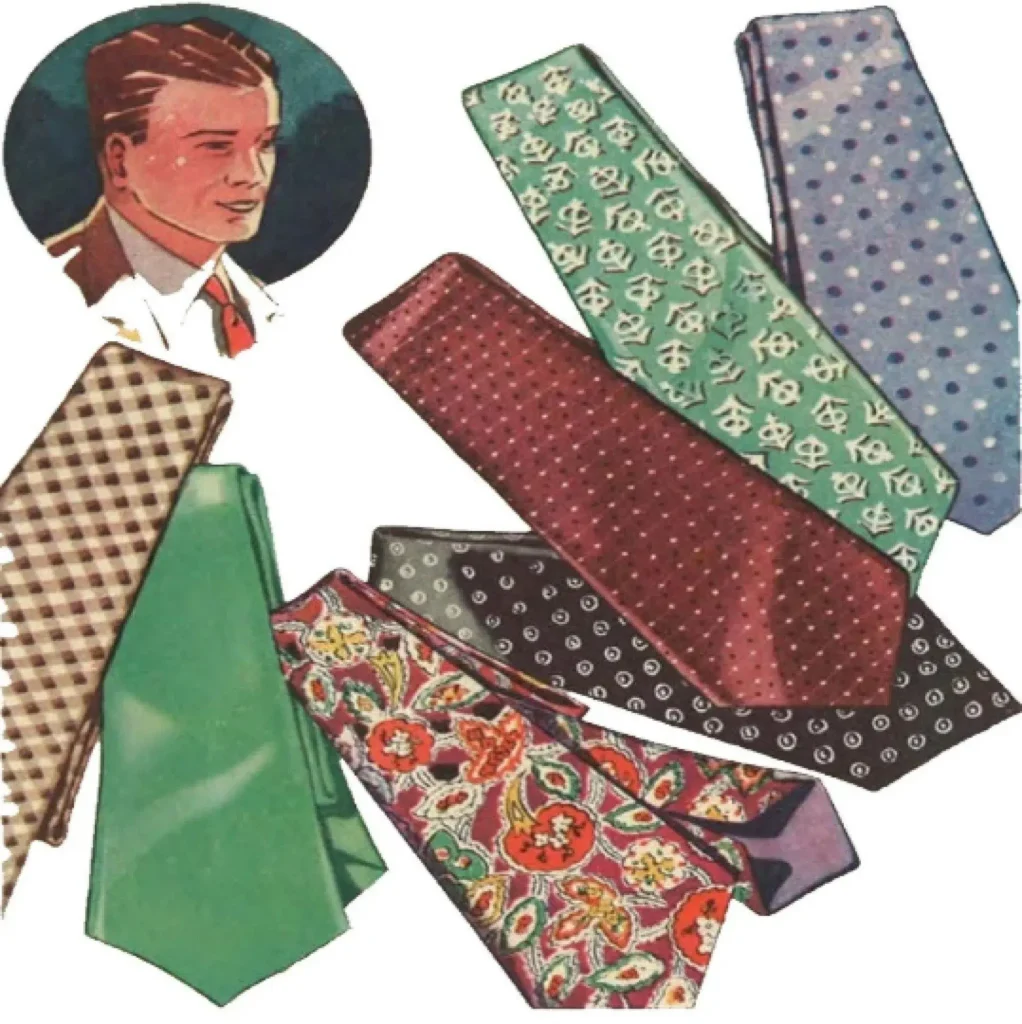
1940s: Bold WWII Era Ties
A selection of late-1940s “Swing” ties showcasing the era’s bold colors and abstract patterns. Post-WWII ties were often hand-painted with vibrant designs to express personality.
Tie Characteristics: In the 1940s, tie styles split into two phases – wartime conservatism and post-war exuberance. During the early 1940s (World War II years), neckties were subdued in color and materials. Silk was scarce due to war rationing, so ties were made of rayon or wool blends. Patterns were simple or military-inspired: think muted stripes or patriotic color combos on a plain background. Ties were also worn shorter (often ending above the belt) because men’s trousers were cut high-waisted and the fabric was rationed. However, once WWII ended, men’s ties took a dramatic turn. By the mid-to late-1940s, ties became wide – very wide (often 4 to 5 inches at the blade, earning nicknames like “belly warmers” for covering the torso) – and featured outrageously bold patterns. Geometric abstracts, surreal “modern art” designs, tropical and Western themes, playing cards, pin-up girls – almost any motif appeared on 1940s ties as a form of personal expression. Hand-painted ties were especially popular; men collected them like art. Colors were rich and joyous: deep maroon, emerald green, golden yellow, royal blue, and patriotic red-white-and-blue combinations were common. These flamboyant ties (often part of the 1948 “Bold Look” in menswear) were a reaction against the drab war years. Knot styles also went big – the Windsor knot was used widely to fill spread collars on dress shirts. In summary, 1940s ties ranged from humble to splashy, but the lasting image of the era is the powerfully patterned, wide tie that makes a statement.
How to Style a 1940s Tie Today:
- Formal: A bold 1940s tie can be a fantastic statement piece for a formal or semi-formal event, as long as you let it take center stage. Since these ties are often very wide and colorful, pair them with a simple, neutral suit. For example, wear a charcoal or navy single-breasted suit with a crisp white shirt, and add a vintage late-40s tie covered in a vibrant abstract pattern or a hand-painted scene. The plain backdrop of your suit will highlight the tie as the focal point. Keep other accessories minimal – maybe a solid pocket square that picks up one of the tie’s colors – so nothing clashes. This way, you capture the post-war dapper look (imagine a 1940s gentleman at a dance, sporting a jazzy tie) in a manner that still feels elegant for today’s formal occasions.
- Business: To incorporate a 1940s tie in a professional setting, choose one of the era’s more restrained patterns or colors. Early-40s ties or “conservative” 40s ties (like diagonal stripes in burgundy and navy, or small foulard prints on a solid background) are easier to blend into business attire. Pair a vintage maroon-and-blue striped 1940s tie with a modern light blue dress shirt and a gray or navy suit. This combination looks quite classic – the tie brings subtle vintage charm without being loud. If you do go for a bolder late-40s tie at work, make sure to balance it: wear a suit with broader lapels to match the tie’s width and stick to simple shirt colors. For instance, a gold and brown abstract-pattern 1947 tie could work with a brown tweed blazer, cream shirt, and no other patterned pieces. By coordinating colors and keeping the rest of the outfit simple, a 1940s tie can add character to a business dress without overpowering it.
- Casual: The whimsical themes of many late-1940s ties make them great for creative casual outfits. You can have fun with these! Try wearing a vintage 40s novelty tie (maybe one with a fun print like musical notes, tropical plants, or cartoonish figures) with a laid-back outfit. For example, take a denim or chambray shirt, leave it untucked over slim chinos, and loosen a colorful 1940s tie around the neck. You could add a casual unstructured blazer or even a leather jacket on top for a high-low mix. Because the tie is vintage and cheeky, it reads as a deliberate style statement. Vintage ties with strong novelty patterns often work best in relaxed settings – think parties, creative meetups, or date nights – where you can show a bit of personality. Another casual approach is to repurpose the wide tie as an accessory: some style-savvy folks wear a 40s tie as a sash or belt over a shirt dress, or even frame particularly beautiful hand-painted ties as wall art. However you use it, a 1940s tie in a casual ensemble adds a pop of retro flair and a story to tell.
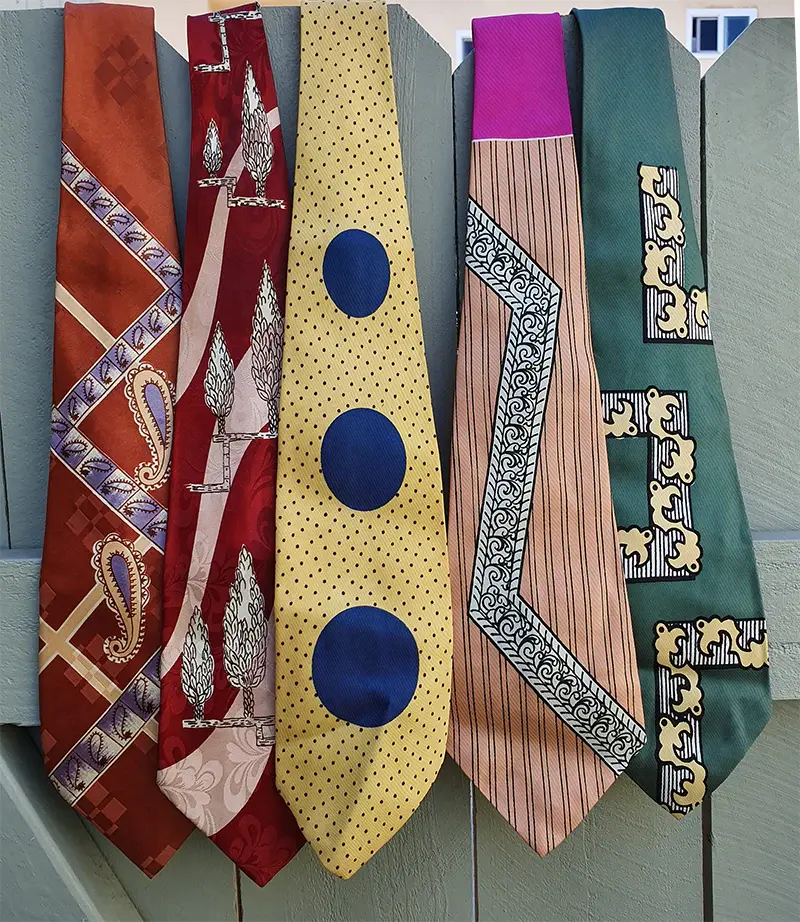
1950s: Mid-Century Modern Style
Mid-1950s ties showing the era’s shift: earlier 50s ties still had lively art prints (left), while later 50s ties became narrower with more subdued designs (right).
Tie Characteristics: The 1950s began with a continuation of the bold “art” ties of the late ’40s and then swung to a more conservative look by the decade’s end. In the early 1950s, hand-painted and printed ties were still trendy – but the designs moved toward abstract modern art shapes and atomic-age motifs (cubist splashes, starbursts, playful squiggles) rather than the hobby and novelty themes of the ’40s. These ties are highly collectible now for their mid-century art feel. As the decade progressed, tie widths started narrowing. By the mid-50s, a “normal” tie width was around 3 to 3.25 inches, and by the late 1950s ties slimmed down to about 2 inches – heralding the coming skinny-tie era. Colors and patterns also calmed down for mainstream business wear. The classic image of a 1950s businessman is the “Man in the Gray Flannel Suit” with a charcoal suit, white shirt, and a muted regimental striped tie. Indeed, graduated stripe ties, simple foulards, and small repeating patterns in neutral colors (navy, brown, and gray with touches of dusty pink or pale blue) were common for work. That said, youth culture kept some flair: college students and the Ivy League crowd rocked knit ties and thin wool ties (a throwback to the 20s), and there was a surge in bow tie popularity around 1957 as a fun, formal-meets-playful accessory. Fabrics in the ’50s were innovative – new synthetic materials like Dacron (a type of polyester) and acrylic knits appeared, offering textured weaves and wrinkle-resistant ties. Also, ties in shantung silk or wool blends provided nubby textures that were fashionable mid-decade. By the end of the 1950s, the skinny tie and its cousin, the continental tie (a thin ribbon-like crossover tie held with a clip), set the stage for the mod styles of the 60s. In summary, 1950s ties evolved from bold to conservative, with a trend toward slimmer shapes and classic patterns as the decade went on.
How to Style a 1950s Tie Today:
- Formal: For formal events that aren’t black-tie, a late-50s look can be very sharp. Try a slim 1950s silk tie (2 to 3 inches wide) with a modern tailored suit. For example, a solid black or deep navy skinny vintage tie paired with a slim-cut suit and white shirt creates a timeless “Mad Men” style ensemble (though Mad Men is set in the early ’60s, the look is inspired by late-50s fashion). You could even wear a fedora or pocket square for a full Rat Pack vibe if the occasion is festive. On the other hand, if you want to use an early 50s bold tie for a formal touch, make that the star: for instance, a 1951 silk tie with an abstract art print in teal and gold can elevate a simple dark suit at a cocktail party. Just keep your shirt solid and accessories minimal to let the mid-century print shine. Whether you choose slim and simple or bold and artsy, a 1950s tie adds mid-century elegance to formalwear.
- Business: The 1950s were all about looking put-together at the office, which translates well to today’s business casual standards. To channel that ’50s businessman style, pair a gray or navy suit with a vintage 50s tie in a classic pattern. A perfect choice is a regimental stripe or small geometric print tie from the mid-50s, ideally in muted tones. For example, a gray flannel suit with a white or light blue dress shirt and a 1950s navy-blue tie with diagonal white stripes is a fail-safe combo. It’s conservative, yes, but also effortlessly stylish and retro in a subtle way. If you want a bit more flair, opt for a 50s tie with a slight sheen or texture – say a dark silk tie with a woven geometric pattern – to add interest without breaking dress codes. Remember that many 50s ties are shorter than modern ones; you can use a tie bar to keep it in place (and a silver tie bar itself gives a vintage touch). Overall, integrating a neat 1950s tie into your work wardrobe is simple and effective – it reads as classic rather than old-fashioned.
- Casual: For casual or creative outfits, you can borrow elements from both the greaser rock-and-roll style and the Ivy League prep style of the 50s. One idea: wear a skinny 1950s tie with a casual shirt and jeans for a rockabilly feel. For example, a skinny red 50s tie with a short-sleeve white button-down, dark cuffed jeans, and boots immediately gives off retro vibes – you could throw on a leather jacket to channel a bit of James Dean cool. On the flip side, channel the Ivy League look by wearing a knit tie from the 50s with a cardigan or blazer. A vintage 1950s knit tie (maybe a square-end wool tie in burgundy) over an Oxford shirt, along with a camel-colored v-neck sweater and chinos, creates a collegiate, semi-casual outfit. Don’t be afraid to experiment with bow ties as well – a 50s-era bow tie in a small polka dot or atomic print can be worn with a casual button-down and a lightweight cardigan for a quirky coffee-date outfit. The 1950s had a fun side (think sock-hop dances and drive-in movie dates), so incorporating a tie from this era into casual wear can give your look a playful, nostalgic twist.
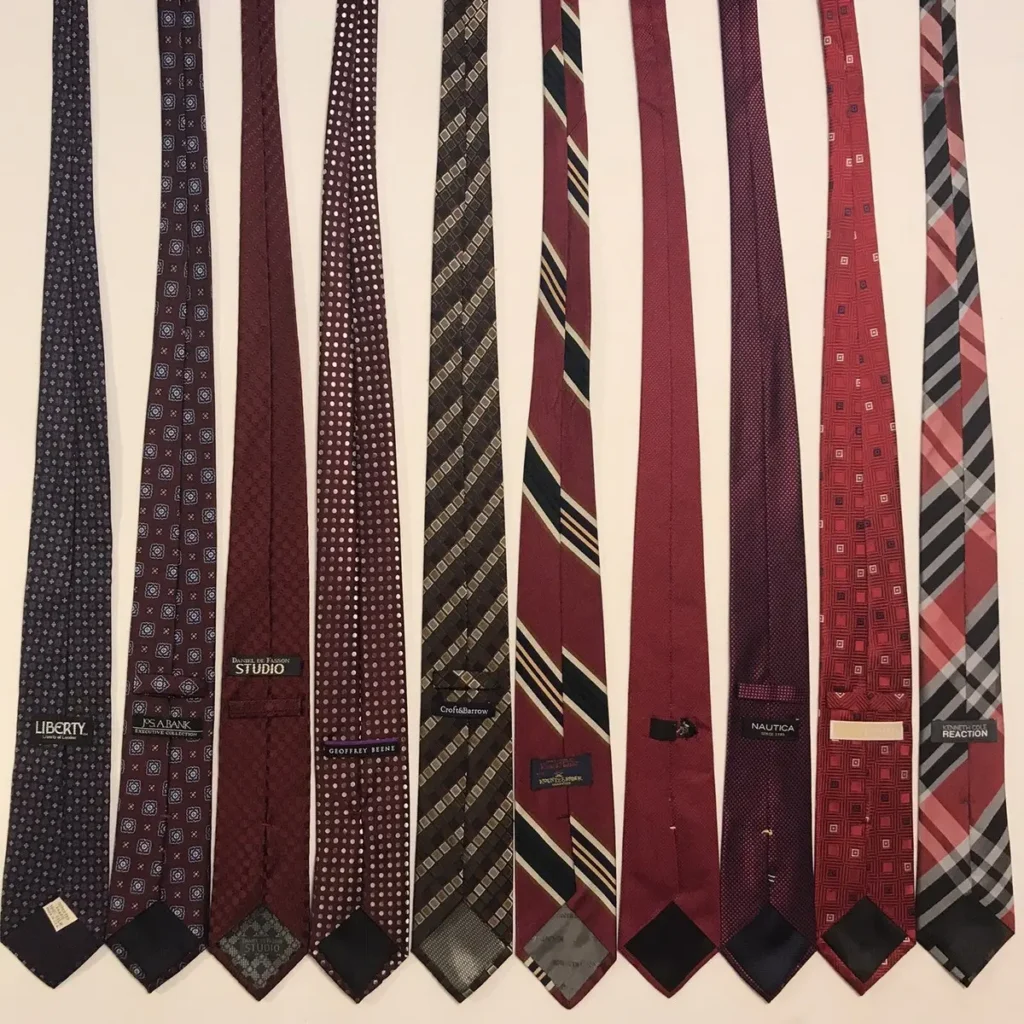
1960s: From Skinny to Psychedelic
Tie Characteristics: The 1960s were a decade of dramatic change in fashion, and ties were no exception – they swung from one extreme to the other. In the early 60s, the prevailing style was the ultra-slim tie. Neckties narrowed to about 2 inches or even less to match the trim, tailored suits of the era (consider the sleek suits worn by the Beatles or in Mad Men). These skinny ties often came in solid dark colors or subtle patterns like narrow stripes and simple textures – a very minimalist, modernist look compared to the splashy 40s and 50s. Black, navy, or charcoal skinny ties were staples of young professionals and the Mod subculture alike. Both pointed-end and square-end skinny ties were popular, sometimes called “Slim Jims” (especially in Britain’s Teddy Boy culture). By the mid-60s, however, experimentation returned. The Mod movement embraced bright colors and pop art influences, so ties started showing up in pinks, purples, aquas, and yellows with bold geometric designs and op-art prints. The ascot (a puffed silk cravat worn inside an open shirt collar) also had a trendy revival around 1964-65 for a chic, jaunty look. Then, roughly around 1967-1968, fashion did a 180: wide ties came roaring back, bigger and bolder than ever. The late 60s introduced the “Kipper tie,” a super-wide necktie (up to 5 inches) with loud colors and psychedelic patterns. British designer Michael Fish is credited with creating the kipper tie – these were meant to be attention-grabbing and fun, often featuring swirling psych prints, floral motifs, or even small medallion and paisley patterns in eye-searing hues. It was a clear break from the restrained early 60s; instead, it embraced the free-spirited hippie vibe. By the end of the decade, many young people eschewed ties except for the most formal occasions (proms, weddings), often opting for bow ties in creative fabrics or even velvet if a tie was needed. Essentially, the 1960s tie span goes from the slick skinny tie of the Kennedy years to the psychedelic wide tie of the Woodstock years – a wild ride in just 10 years!
How to Style a 1960s Tie Today:
- Formal: If you love the clean tailoring of the early 60s, a skinny 1960s tie is perfect for formal occasions now. Pair a vintage slim tie (around 2 inches) with a modern slim-fit suit to achieve that refined silhouette. For example, a black silk 2-inch tie from the 60s worn with a slim-cut black or charcoal suit and white dress shirt creates a timeless James Bond elegance. It’s understated yet incredibly stylish – ideal for weddings, cocktail parties, or any event where you want to look sharp. You could add a tie clip for a touch of mid-century detail (just place it between the 3rd and 4th shirt buttons). If the event is creative or retro-themed, you might instead showcase a late-60s wide psychedelic tie with a simpler suit. In that case, tone down the rest: a solid color suit in black or navy and a white shirt will frame a bold 1969 swirling-print tie nicely. It’s a more daring formal look, suited for those who want a punch of personality in their attire.
- Business: Incorporating a 1960s tie into business attire can set you apart in a tasteful way. For a classic approach, use the early-60s skinny tie style as inspiration for office wear. A slim vintage tie in a neutral tone (skinny navy with a subtle texture or narrow stripe) worn with a gray slim-fit suit and crisp shirt will read as modern and professional, with a subtle nod to the 60s mod style. This look is very boardroom-appropriate, especially if you stick to conservative colors. On the other hand, you can add a bit of color with a mid-60s Mod tie: perhaps a thin silk tie in burgundy or forest green with a simple geometric pattern, to liven up a navy blazer and khaki trousers combo. Generally, avoid the ultra-wide late-60s ties in strict business settings – those psychedelic kipper ties are better saved for casual Friday or creative industries. But if you do wear one, make sure your shirt and suit are very subdued and let that tie be the one playful element. And always mind proportions: a broad kipper tie can look out of place on a narrow-lapel jacket, so wear it with a jacket that has a wider lapel or a more relaxed cut. In sum, the 60s offer two great business style options: sleek minimalism or modish flair – choose what fits your personality and office environment.
- Casual: The 1960s provide lots of inspiration for casual styling with ties, from preppy to avant-garde. One easy win is the mod casual look: take a skinny 60s tie and wear it loosely with a slim-fitting cardigan or V-neck sweater instead of a suit jacket. For example, a narrow plaid 1960s tie over a simple white Oxford shirt, topped with a black cardigan and paired with slim jeans, creates a retro-cool outfit for a night out or a concert. You could even wear Chelsea boots to complete the mod vibe. If you’re channeling the late-60s style, try a bold paisley or floral kipper tie in a casual ensemble. These wide, colorful ties can be worn almost like a scarf. One idea: wear a 70s-style printed shirt (with a big collar) but leave it open and instead of a necklace, knot a late-60s psychedelic tie loosely around your neck – almost like a bandana or ascot hybrid. This has a funky, festival feel (think Hendrix or Beatles in their psychedelic phase). For a more low-key approach, you might simply wear a bright vintage tie as an accent with a casual blazer. For instance, a navy blazer, white T-shirt, and jeans could be dressed up with a 1960s tie used almost like a fashion accessory – not tightly cinched, but knotted and left a bit shorter, channeling that carefree youthfulness of the era. The main point in casual styling is: to have fun with it. The 60s were about breaking rules, so you can be inventive – whether it’s pairing a slim tie with a leather jacket for a rocker look or wearing an outrageous wide tie with a simple shirt just because you like it. Confidence is key to pulling it off.
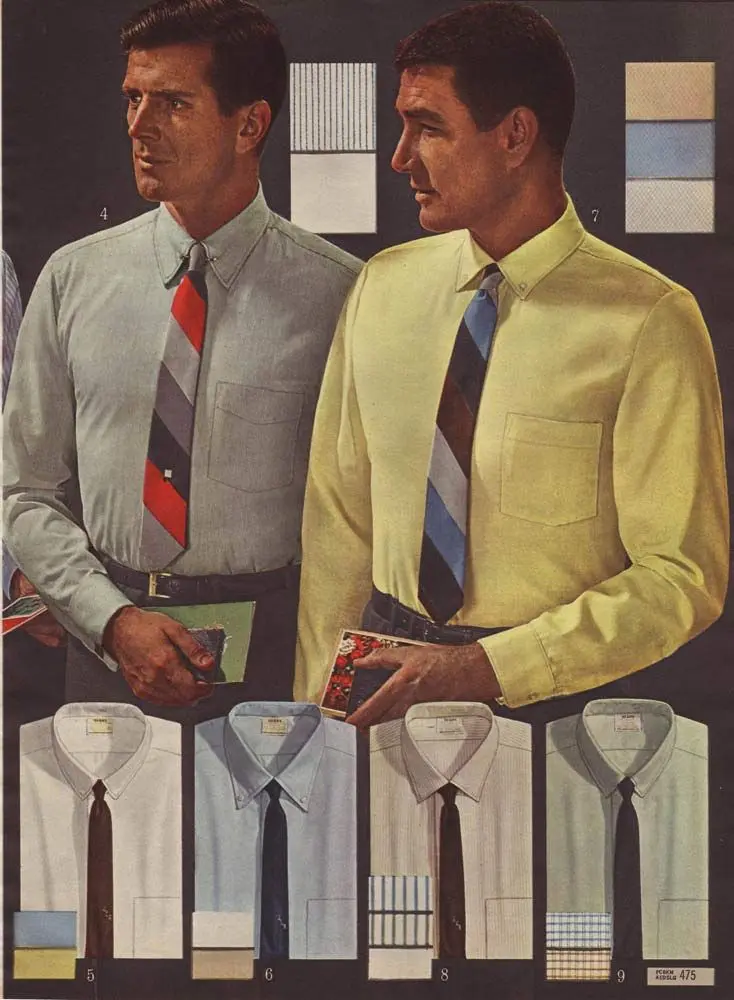
1970s: Wide & Wild
A lineup of 1970s “kipper” ties – extremely wide blades with loud patterns (from rustic wagon scenes to paisley swirls and plaids) were emblematic of ’70s style.
Tie Characteristics: In the 1970s, bigger was better when it came to ties. The conservative backlash of the early 60s was long gone; instead, the decade embraced the liberated, flashy spirit of the late 60s and turned it up a notch. Ties became the widest they had ever been, often about 4 to 4.5 inches across at the blade. These ultra-wide ties – commonly called “kipper ties” (continuing the late-60s trend) – were designed to catch the eye and coordinate with the equally wide lapels on men’s coats and the big collars on shirts. The patterns on 1970s neckties were bold, unapologetic, and often psychedelic. Popular motifs included large paisley swirls, floral prints (think big daisies or paisley mixed with flowers), geometric shapes, diagonal color-block stripes, and inventive novelty prints. Earthy tones were very much in vogue too: lots of browns, olive greens, mustard yellows, and burnt oranges, often combined in wild patterns. At the same time, the influence of the hippie movement introduced brighter rainbow colors and pastel trippy designs on ties (clouds, rainbows, abstract art in soft hues). Polyester became a go-to fabric for ties in this era – it was inexpensive and allowed for easy-care ties with a bit of sheen, and it took colors very vividly. Many 70s ties have a distinctive texture or sheen due to polyester or poly blends. Knit ties also appeared (somewhat more in the late 70s) but were overshadowed by the dominance of printed silk/polyester kipper ties. The bow tie saw an exaggerated revival too – 1970s bow ties were oversized “butterfly” shapes, often in loud prints, as part of the tuxedo fashion of the time. Another trend was the neckerchief: some men in the early 70s wore square silk scarves tied at the neck instead of a tie, a look borrowed from hippie styles and leisure suit culture. By the late 70s, however, the pendulum swung again – the disco era also welcomed open shirt collars with no tie at all, especially for nightlife (John Travolta’s Saturday Night Fever look with a suit and open shirt is iconic). Overall, the 1970s tie can be summed up in two words: wide and wild. It was a decade of confident and often flamboyant style, reflected perfectly in its neckwear.
How to Style a 1970s Tie Today:
- Formal: Wearing an authentic 1970s tie to a formal event can be a cool retro statement, but you’ll want to do it with intention. Because 70s ties are so wide and bold, they pair best with jackets that have a bit of a vintage cut. If you happen to have a vintage-inspired suit with wide lapels (or even a real 70s suit), that can look great – for example, a cream or light-colored suit with peak lapels, a simple shirt, and a wide 70s paisley tie could be a hit at a themed party or a creative dressy event. For a more subtle formal use, take a solid color 1970s tie – yes, they existed! – perhaps in a jewel tone like emerald or burgundy, and wear it with a modern suit. The tie will still be wider than today’s standard, but a solid or simple pattern won’t look too outrageous. Finish with polished shoes and maybe a coordinating pocket square. Avoid pairing a super busy 70s tie with a tuxedo or very formal dark suit unless it’s a fun occasion – for a typical black-tie optional wedding, for instance, a huge butterfly-print tie might be too distracting. But if the vibe is right, leaning into that flamboyant 70s formality (ruffled shirt, velvet suit, big tie) can be memorable and stylish in a tongue-in-cheek way.
- Business: The office is probably the trickiest place to deploy a full-1970s tie, but it can be done in a fashion-forward or vintage-friendly workplace. The safest bet is to use a striped or geometric 1970s tie since stripes are always office-friendly. For instance, a 4-inch-wide 1975 tie with diagonal stripes in navy, maroon, and gold can look powerfully traditional when worn with a navy suit – it’s akin to the “power ties” that came in the 80s. Colleagues might not even realize it’s vintage unless they look closely. Just be sure to use a large knot (a half-Windsor or Windsor) to properly fill the collar, since the tie is thick. If you have a flamboyant patterned tie (say, a huge paisley or a scene of Edwardian carriages, as seen on some novelty 70s ties), you can tone it down by layering. Wear it under a v-neck sweater or a sweater vest, which will cover some of the pattern and just show a pop of color at the chest. This can look quite stylish – imagine a brown tweed vest over a light blue shirt, with the bloom of a 70s tie’s floral pattern peeking out. The key in a professional setting is to limit the loud tie to one per outfit and keep everything else conservative. Also, note that a wide tie might feel odd with a skinny modern suit; it pairs better with a suit or sport coat that has a bit broader fit. If your wardrobe leans slim-cut, a 70s tie might be better saved for casual looks.
- Casual: Here’s where 1970s ties can truly shine and be a lot of fun. Embrace the quirkiness: use a wild 70s tie to inject life into simple casual pieces. One approach is a boho look – take a colorful floral 1970s tie and wear it loosely with a fitted denim shirt (snap-button Western shirts were a 70s staple) and some faded bell-bottom jeans or modern boot-cut jeans. Roll up the sleeves, maybe add some leather bracelets, and you’ve got a chill vintage vibe perfect for a music festival or a weekend outing. Another idea: knot a ’70s tie around your neck like a kerchief. For example, pick a groovy scarf-like polyester tie with a psychedelic print and tie it in a loose knot over a T-shirt and an unbuttoned casual shirt. It’s almost like an ascot, giving you a rockstar flair (think David Bowie in his 70s era, who often played with ties and scarves). You can also repurpose old wide ties in crafty ways – some style enthusiasts sew two 70s ties together to make a unique belt, or even use the fabric to create pockets on a shirt. If you’re just wearing the tie normally, consider the shirt collar: try a retro wide-collar shirt (which has returned in some modern collections) with the big tie for a full 70s effect. A printed shirt with a contrasting printed tie can be very fashion-forward if done deliberately (the 70s were no stranger to pattern-mixing!). For instance, a subtle polka-dot shirt under a bold diagonal-stripe tie, grounded by a solid blazer, can look avant-garde yet anchored. In everyday wear, a 1970s tie is a great conversation starter. It shows you don’t take yourself too seriously and that you appreciate vintage style. Wear it confidently – that’s the true ’70s spirit, after all.
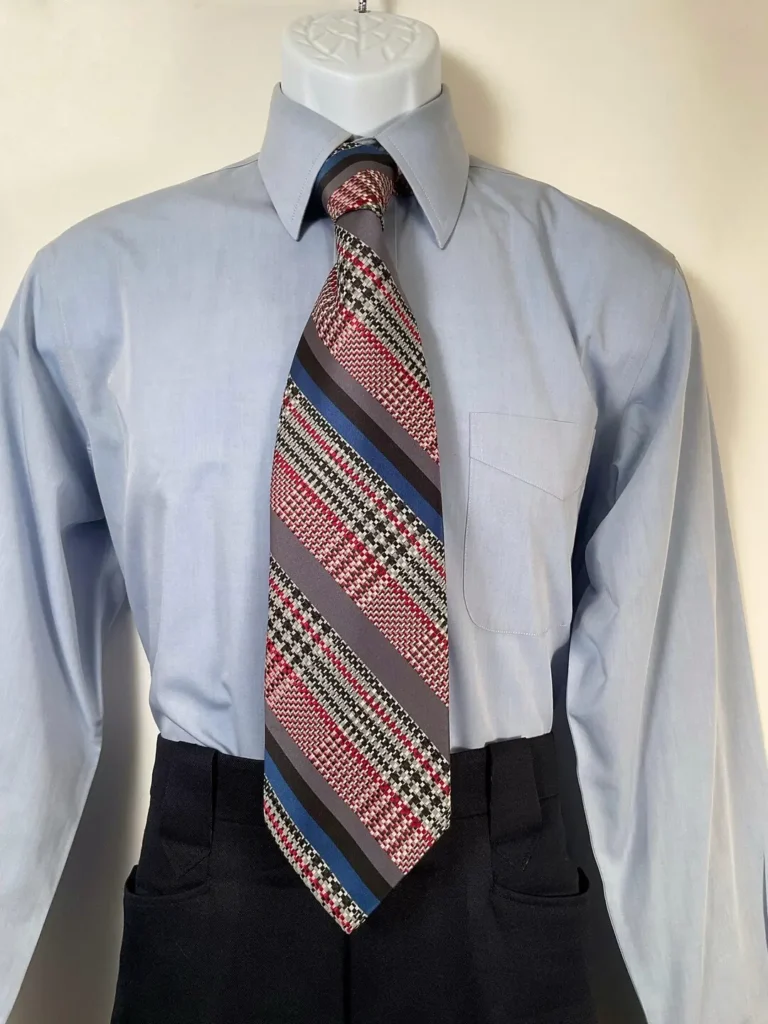
1980s: Power Ties and Novelty Prints
Novelty ties from the 1980s featuring bold motifs – from vintage cars to musical instruments and pop culture icons. These fun patterns were a counterpoint to the era’s conservative “power ties”.
Tie Characteristics: The 1980s swung the pendulum back from the wild 70s to a more authoritative look in men’s neckwear, at least in the professional sphere. The term “power tie” emerged in the 80s. This typically meant a wider tie (though not quite as wide as a ’70s kipper) in a strong, solid color or bold pattern that conveyed confidence – famously, a bright red tie against a navy or gray suit (Ronald Reagan and characters like Gordon Gekko in Wall Street popularized this image). Indeed, in the 1980s power dressing was at its peak, and ties became symbols of authority and success. Common patterns for business ties included diagonal stripes (often in muted tones or two-tone schemes), simple foulards, paisleys, or geometrics, usually set against deep hues like navy, burgundy, or hunter green. Ties were still fairly wide – around 3.5 to 3.75 inches was standard – to match the broad shoulder pads in suits. Silk was the fabric of choice again (polyester was seen as cheaper, and the 80s loved displays of luxury), though you’d also find ties in shiny satin finishes or with a slight texture. We also see knit ties make a comeback in the 80s: square-end silk or wool knit ties, often in solid dark colors, became a preppy staple and were worn skinny (about 2 inches, a throwback contrasting the prevalent wide look) – for example, characters on Miami Vice or Family Ties sported knit ties for a trendy touch.
But the 80s had its quirky side too. Alongside the boardroom power tie, there was an explosion of novelty ties. These were ties with playful prints: think cartoon characters (Mickey Mouse or Looney Tunes), holiday themes (Christmas ties with Santa or reindeer), piano keys, celebrity faces, etc. They were often worn somewhat ironically – for instance, a businessman might wear a Bugs Bunny tie on a casual Friday to show a lighter side. The 80s also revived some subcultural styles: the skinny black leather tie became a New Wave music fashion statement (thanks to bands like The Blues Brothers and various punk/New Wave groups). So while the mainstream was all about the bold power tie, there was a counter-trend of creative and humorous neckwear. By the late 1980s, both trends had cemented: you’d see Wall Street men in dark suits and red or yellow power ties, and you’d also see the rise of designers making limited-edition art ties (this would carry into the 90s with people like Jerry Garcia designing ties). In summary, the 1980s tie landscape ranged from serious and status-driven to whimsical and anti-establishment. Key features were moderate-to-wide widths, rich colors for the serious side, and wild-themed prints for the fun side.
How to Style a 1980s Tie Today:
- Formal: An 1980s power tie can be a brilliant choice for a formal or business-formal event even now. The classic example: is a solid red silk tie with a dark suit. This combo is timeless (often seen in politics and law even today) and exudes confidence. To avoid looking too plain, you can choose a red tie with a subtle pattern – like a tonal paisley or a neat dot – which adds interest up close. Pair it with a charcoal gray suit, white shirt, and perhaps a white pocket square for a clean, formal look. Another formal styling could be using a rich 80s paisley tie. For instance, a navy tie with regal gold paisley, from a high-end 80s designer, worn with a three-piece navy suit can look very distinguished (the 80s loved paisley as a sign of luxury). One more note: if you have a novelty 80s tie that is on the dressier side (say, a tie with a tasteful Art Deco pattern or a subtle weave that isn’t too cartoonish), you could incorporate it at a formal event to show a bit of personality. For example, a music lover might wear an 80s tie printed with tiny violin motifs to a symphony gala – it’s thematic and fun but still silk and classy from a distance. As long as the colors coordinate with your suit, an 80s tie can be the element that sets you apart in formal wear with a touch of either power or playfulness.
- Business: The office is where 1980s ties truly shine. To channel that power dressing era, try assembling a “Wall Street” inspired outfit. Start with a dark pinstripe or solid suit (navy or gray). Add a contrast-collar dress shirt if you want extra 80s flavor (those white-collar blue shirts were iconic). Now pick out a bold vintage 80s tie – perhaps a red power tie or a striped tie in deep tones. Complete the look with black cap-toe shoes and maybe suspenders (braces) if you’re leaning in. This outfit projects authority and a bit of retro cool. If this feels too banker-costume, you can tone it down: use a vintage 80s tie with a more contemporary slim-cut suit for a modern power look. For instance, a burgundy 1980s tie with subtle diagonal stripes could add a confident touch to a slim charcoal suit; it’s less skinny than today’s ties, which makes a bold style statement now. On the other side of the 80s spectrum, if your workplace allows, you could sport an 80s novelty tie on casual days. A lot of us have seen the office colleague with the Garfield or Mickey Mouse tie – that trend started in the ‘80s. Worn with an Oxford shirt and chinos, a vintage novelty tie can show you don’t take yourself too seriously. Just ensure the rest of your outfit is low-key so you don’t look too chaotic. For example, a simple light gray sweater over a collared shirt, with an ’80s tie adorned with little golf clubs (for casual Friday when you’re dreaming of the golf course), strikes the right balance of professional and playful.
- Casual: Styling a 1980s tie casually can be a lot of fun because you can play with the novelty aspect or the skinny tie revival of that era. One idea is to emulate the New Wave look: grab a skinny leather or knit tie from the 80s and wear it loosely with a graphic tee, slim blazer, and jeans. This gives off a cool retro vibe (think late-’80s teen movie or club scene). For instance, a skinny black knit tie hanging loosely over a Ramones t-shirt with a black blazer – it’s edgy and throws back to the alternative style of the time. If you have an original leather tie, that’s even more punk rock and will be a conversation piece. For a different casual take, lean into the preppy side of the 80s. Wear a square-bottom knit tie (maybe a dark green or navy one) with a checked button-down, rolled-up chinos, and boat shoes – a sort of “country club casual” look that’s very timeless. The knit tie keeps it relaxed and was a signature preppy item in the 80s. And let’s not forget the pure novelty ties: those can be centerpieces of a casual outfit. For example, an 80s tie with a print of vintage cars (like the one in the image above) could be worn with a chambray shirt and brown corduroy jacket for a quirky vintage-inspired day look. Or an Elvis-print tie (the 80s had a lot of ’50s nostalgia) could be paired with a leather jacket and white tee, merging 50s rockabilly and 80s kitsch. When wearing loud 80s ties casually, it often works to embrace a bit of an ironic tone – you’re wearing it partly because it’s “so 80s.” Mix in some modern trendy pieces so it’s clear your outfit is deliberate. Ultimately, whether you go preppy, punk, or tongue-in-cheek, a 1980s tie can add a pop culture punch to your casual wardrobe.
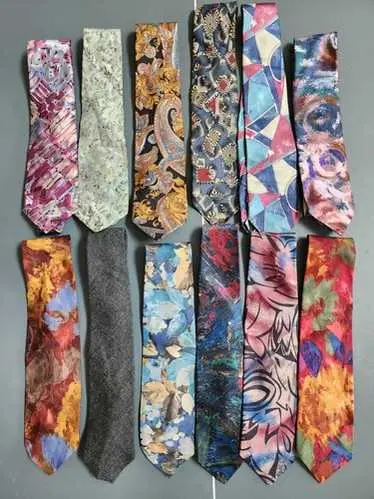
1990s: From Bold Prints to Business Casual
Tie Characteristics: The 1990s continued some trends from the late 80s but also saw the influence of the growing business casual movement and diverse style subcultures. In the early 90s, tie width was still on the wider side – about 3.75 to 4 inches were common among designers. Many 90s ties featured bold motifs, especially paisleys and floral-inspired patterns in rich colors. It was almost a throwback to the 1940s in terms of pattern scale but with a 90s color palette (deep teals, burgundy, hunter green, mauve, etc.). Designers often played with abstract art prints on ties – notably, Jerry Garcia of the Grateful Dead launched a popular line of ties in the 90s that had vibrant, artsy patterns, essentially wearable art. These were embraced in offices as a tasteful way to have a unique tie. Novelty ties remained popular too, perhaps even more so: ties with Looney Tunes characters, Americana prints, sports team logos, and so on were favorite gifts and found their way into many wardrobes. On the flip side, the “less is more” minimalist trend of the 90s also influenced ties. By the mid-to-late 90s, you saw a swing back to slimmer ties (not skinny, but more moderate ~3.25-inch widths) in solid colors or simple designs, reflecting the pared-down aesthetic of the era’s fashion (think of the slim black ties in Reservoir Dogs or the sleek style in The Matrix towards 1999). Additionally, the rise of tech culture and casual Friday meant many men simply wore ties less often. The 90s had phases where grunge fashion (flannels, band t-shirts) dominated youth style – no ties there – and business casual became a buzzword, leading to open-collar shirts at the office. Still, in traditional or formal settings, ties were present, and often with distinct 90s characteristics: paisley and floral prints were especially trendy in the early 90s, often in silk, and many have a somewhat soft, swirly quality (the kind of tie you might imagine on a TV show dad in the 90s). Colors could be dusty (mauve, olive, gold) or conversely very bright (primary-colored graphics). Another 90s hallmark was thematic ties – for example, ties that commemorated events (a 1996 Olympics tie with the rings and sports images) or ties by artists (Salvador Dalí or Van Gogh print ties became popular). By the very late 90s, a more conservative approach to ties re-emerged (which would define the early 2000s): simpler patterns, and narrower shapes, reflecting a pushback against ’90s excess. In sum, the 90s tie scene was a mixed bag: vibrant and eclectic in the first half, gradually shifting to simpler and slimmer by the end, all under the growing shadow of casual dress codes.
How to Style a 1990s Tie Today:
- Formal: Early 90s ties can add a nice splash of color to formal outfits today. For example, if you have a vintage 90s silk tie with an elegant multicolor paisley, it can be a perfect accent for a wedding or dinner event. Wear it with a dark suit (black, navy, or deep gray) and a light shirt to let the tie’s pattern pop. Interestingly, those big paisley and floral ties from the 90s are quite in line with current trends – fashion always circles back, and bold printed ties have been making a comeback. So you might look very fashion-forward wearing a 90s tie now! Just ensure the width doesn’t overwhelm your suit; if it’s one of the very wide ones, use a substantial knot and a suit jacket with decent lapel width. For formal events, you might avoid the ultra-novelty 90s ties (like cartoon characters) and stick to the ones with abstract or classic patterns. Also, the 90s saw the advent of colorful suspenders and cummerbund sets for black-tie optional events – you can channel a bit of that by, say, matching a pocket square to one of the colors in your 90s tie. This creates a cohesive, dressy look. For instance, a 90s tie with navy and gold floral motifs could pair with a gold pocket square and a midnight blue suit for a sharp formal ensemble.
- Business: Wearing a 1990s tie in a modern office can be quite seamless. Many 90s ties are not radically different from today’s, aside from being a touch wider. If you have a collection of vintage 90s ties, break out those paisleys, stripes, and foulards – they convey a sense of classic style with a vintage twist. Try this: a white or light blue dress shirt, a charcoal suit, and a 90s tie with a bold paisley in burgundy and navy. That’s a power look that isn’t too loud but more eye-catching than a plain tie – and it reflects the 90s love of paisley prints. Alternatively, go for the “solid tie” office look that started in the late 90s: a solid deep-purple or forest-green tie (silk, with maybe a slight satin finish) against a gray suit. That was a very popular style in the 90s and still looks polished. If your workplace is more creative, you could even bring out a tasteful novelty tie – say, a tie with tiny computer icons or a tie celebrating a movie – as a nod to 90s pop culture. But use these sparingly in important meetings. One more tip: since many ’90s ties have a lot of color, coordinate them with your shirt in a ’90s way. In the 90s it was common to match the shirt color to one of the minor colors in the tie. For example, if your vintage tie has little green dots, you might wear a green shirt that picks that up. This was a very “90s office” styling trick. You can tone it down by using a pale version of the color so it’s not too matchy-matchy. Embracing these details will make your outfit feel intentionally retro, which comes off as confident and stylish.
- Everyday Casual: With the rise of ’90s nostalgia in fashion (yes, the 90s are now “vintage” to some!), incorporating a 90s tie into casual wear can be fun and on-trend. One easy way is the “prep meets grunge” mix. For example, take a flannel shirt or denim shirt, and instead of leaving it completely open, tie a 90s tie loosely around your neck and wear the shirt untucked over a tee. This clash – dressy tie vs. casual layers – was seen in 90s alt fashion and is making a comeback in streetwear. A tartan flannel with a funky 90s abstract tie and ripped jeans says you’re playing with style conventions. If that’s too daring, consider a simpler casual look: wear a sweater over a collared shirt and use a 90s tie as a pop of pattern peeking out. A vintage Ralph Lauren or Tommy Hilfiger tie from the 90s (these often had classy regimental stripes or crests) worn under a navy crewneck sweater with khakis gives off a nostalgic Ivy League vibe. Also, don’t shy away from the novelty ties for casual statements – a tie with 90s cartoon characters (Ninja Turtles, anyone?) can be a cool accessory if you’re going to a 90s-themed party or just feeling playful. For example, you could wear a Space Jam printed tie loosely with an oversized button-down and baggy light-wash jeans to embrace a 1990s streetwear aesthetic. Sneakers and maybe a backward cap would complete it. On the subtler side, late-90s minimalism can influence your casual look: a skinny black silk tie, white t-shirt, and black leather jacket is a clean, almost Matrix-like style that still holds up. In everyday fashion, the 90s were about both expression and comfort. So whether you rock a loud vintage tie with relaxed layers or a sleek simple tie with edgy pieces, you’ll be capturing the eclectic spirit of 90s style.
Styling Tips Recap: No matter the era of your vintage tie, a few principles will help you wear it with confidence today. Balance is key – if the tie has a busy pattern or bright colors, keep the rest of your outfit solid and neutral. Match the tie’s width with your jacket’s lapel width for a harmonious proportion. When mixing eras, let the tie be the star and use modern garments as the supporting cast (e.g., a 1940s tie with a contemporary suit). For a bold vintage tie, you can echo one of its colors in another accessory (like socks or a pocket square) to pull the look together. And importantly, wear it with pride – vintage ties carry history and personality. Whether you’re dressing for the office, a special event, or just experimenting on the weekend, a tie from the 1920s–1990s can elevate your outfit into something truly memorable and uniquely you. Vintage ties are more than just neckwear; they’re a way to celebrate fashion influences of the past while creating fresh looks in the present. Enjoy the process of discovering which era speaks to your style, and have fun tying it all together!
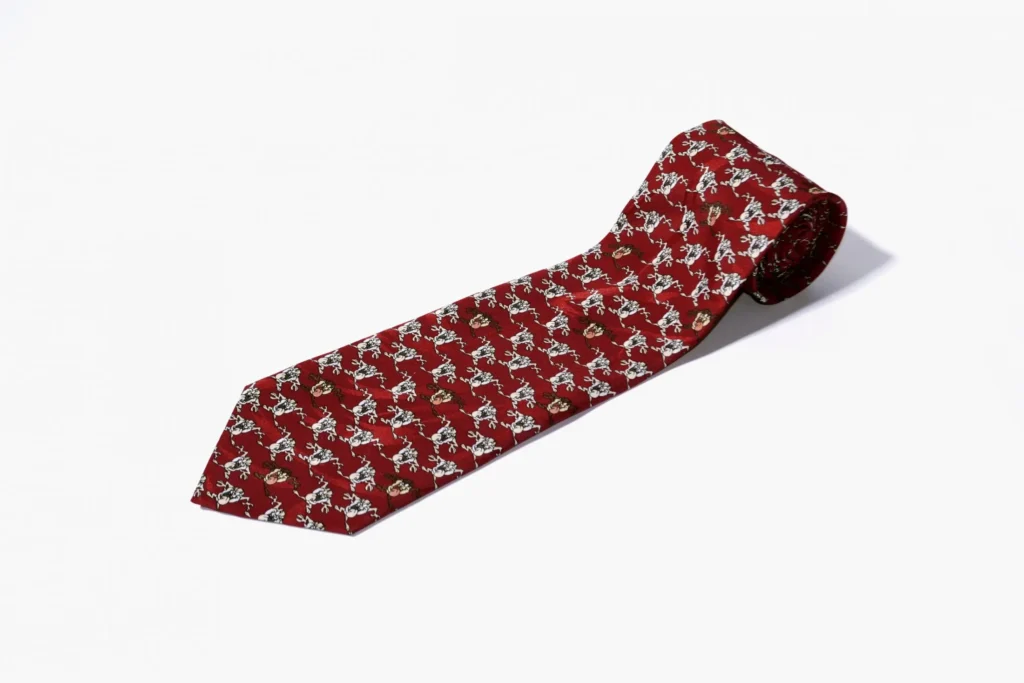

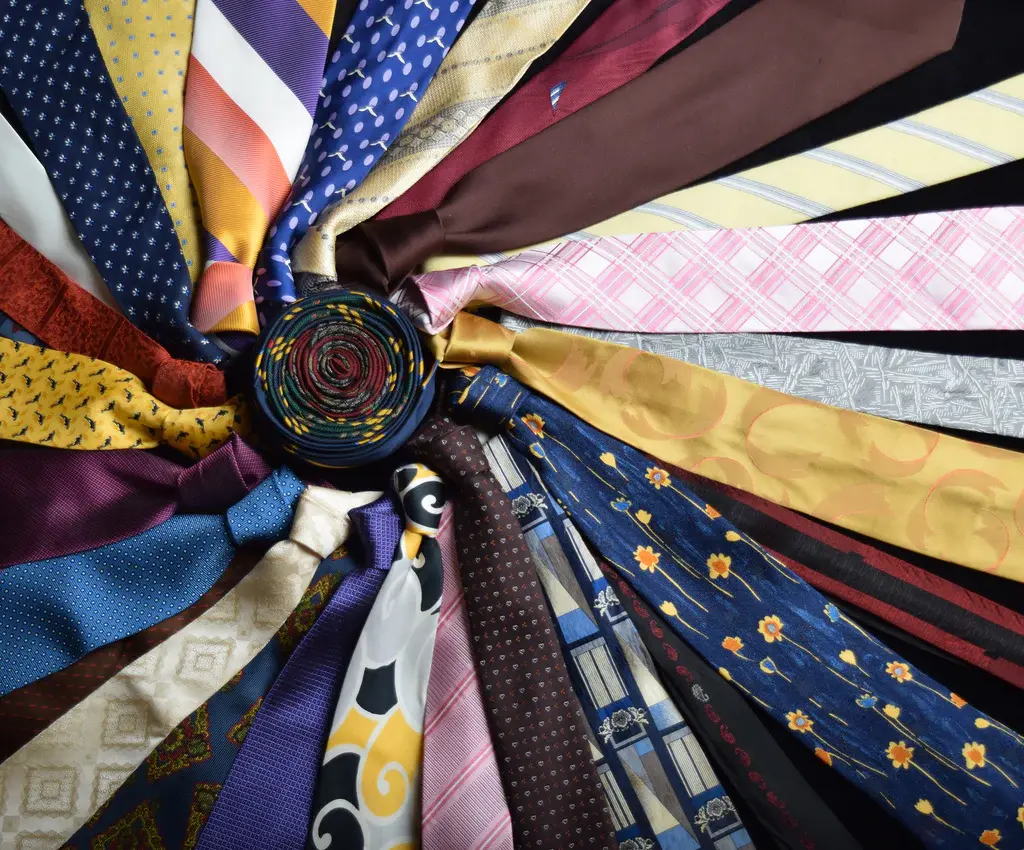
1 Comment
thanks to the author for taking his time on this one.